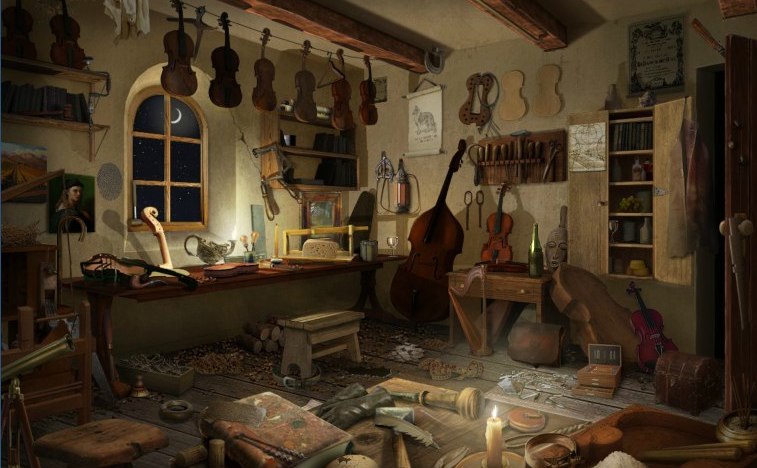Very old Frank Meinradus violin

This is a very old violin made by Frank Meinradus from Linz. The violin is a good shape especially for such age. It doesn't show signs of significant repair. There are no any cracks on it.
The distinctive label that can be found on other Frank's instruments says
Meinradus Frank
Fecit Linz Anno 1804
Please contact us for more details and price
Antique copy of Antonious Stradivarius Cremonenfis

This unique violin was made in France in the beginning of 20th century. It is a very solid instrument. Even for its more than 100 years old it doesn't have any cracks and signs of repair.
There is label inside that says
Copie de
Antonius Stradivarius Cremonenfis
Faciebat Anno 1721
There is another small label:
FRANCE
The violin has a bright brisk sound.
Acoustic-electric violin with pickup

Beautiful full size acoustic violin with builtin electric sound pickup.
This bright acoustic-electric violin sounds and looks very impressive while playing alone or connected to the speaker. The cord and carbon bow are included.
Concert violin by Walter Mahr

Concert quality violin from Bubenreuth, Germany. It is handcrafted instrument made by famous German violin maker Walter Mahr in 2015. The tone woods were carefully selected and dried for at least 10 years. The precious sound of top wood is spruce from Hazel. The 2-piece slightly flamed back is made of bird's-eye maple. The spirit painting is Golden brown. The violin is fitted with ebony Vertebrae with Parisian eye. Fingerboard, tailpiece and chin rest are made from ebony. The violin has a brilliant, powerful bright sound.
There is master signed label inside of violin. The certificate issued and signed by Walter Mahr is also included.
The first clear record of a violin-like instrument comes from paintings by Gaudenzio Ferrari.
In his Madonna of the Orange Tree, painted 1530, a cherub is seen playing a bowed instrument which clearly has the hallmarks of violins.
The instruments Ferrari depicts have bulging front and back plates, strings which feed into peg-boxes with side pegs, and f-holes.
They do not have frets. The only real difference between these instruments and the modern violin is that Ferrari's have three strings,
and a rather more extravagant curved shape.
It is not clear exactly who made these first violins, but there is good evidence that they originate from northern Italy,
in the vicinity of Milan. Not only are Ferrari's paintings in this area, but at the time towns like Brescia and Cremona
had a great reputation for the craftsmanship of stringed instruments.
In the 19th and 20th centuries numerous violins were produced in France, Saxony and the Mittenwald in what is now Germany,
in the Tyrol, now parts of Austria and Italy, and in Bohemia, now part of the Czech Republic.
About seven million violin family instruments and basses, and far more bows, were shipped from Markneukirchen
between 1880 and 1914. Many 19th and early 20th century instruments shipped from Saxony were in fact made in Bohemia,
where the cost of living was less. While the French workshops in Mirecourt employed hundreds of workers,
the Saxon/Bohemian instruments were made by a cottage industry of mostly anonymous skilled laborers
quickly turning out a simple, inexpensive product.
Today this market also sees instruments coming from China, Romania, and Bulgaria.
Copyright © Silver Strings 2000-2024. All rights reserved.
Other company names and logos may be the trademarks of their respective owners.


 This is a very old violin made by Frank Meinradus from Linz. The violin is a good shape especially for such age. It doesn't show signs of significant repair. There are no any cracks on it.
The distinctive label that can be found on other Frank's instruments says
This is a very old violin made by Frank Meinradus from Linz. The violin is a good shape especially for such age. It doesn't show signs of significant repair. There are no any cracks on it.
The distinctive label that can be found on other Frank's instruments says
 This unique violin was made in France in the beginning of 20th century. It is a very solid instrument. Even for its more than 100 years old it doesn't have any cracks and signs of repair.
This unique violin was made in France in the beginning of 20th century. It is a very solid instrument. Even for its more than 100 years old it doesn't have any cracks and signs of repair. Beautiful full size acoustic violin with builtin electric sound pickup.
Beautiful full size acoustic violin with builtin electric sound pickup.
 Concert quality violin from Bubenreuth, Germany. It is handcrafted instrument made by famous German violin maker Walter Mahr in 2015. The tone woods were carefully selected and dried for at least 10 years. The precious sound of top wood is spruce from Hazel. The 2-piece slightly flamed back is made of bird's-eye maple. The spirit painting is Golden brown. The violin is fitted with ebony Vertebrae with Parisian eye. Fingerboard, tailpiece and chin rest are made from ebony. The violin has a brilliant, powerful bright sound.
Concert quality violin from Bubenreuth, Germany. It is handcrafted instrument made by famous German violin maker Walter Mahr in 2015. The tone woods were carefully selected and dried for at least 10 years. The precious sound of top wood is spruce from Hazel. The 2-piece slightly flamed back is made of bird's-eye maple. The spirit painting is Golden brown. The violin is fitted with ebony Vertebrae with Parisian eye. Fingerboard, tailpiece and chin rest are made from ebony. The violin has a brilliant, powerful bright sound.

